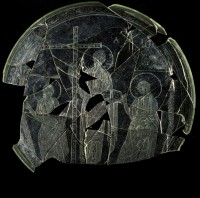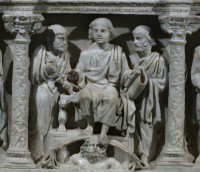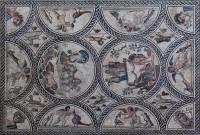 Archaeologists excavating the ancient city of Cástulo in south central Spain have found a glass liturgical vessel from the 4th century that is the earliest known representation of Christ ever discovered in Spain. It’s a paten, a shallow bowl or dish used to hold the consecrated host during the sacrament of the Eucharist. Although it was found in fragments, they’re in excellent condition with only very few details of the decoration eroded, a survival all the more remarkable when you consider that the high quality blown glass is just two millimeters thick. The pieces were painstakingly puzzled together with Paraloid, a thermoplastic resin used as a glass and ceramic adhesive by conservators, to form 81% of the complete dish. In total 175 grams of glass were recovered.
Archaeologists excavating the ancient city of Cástulo in south central Spain have found a glass liturgical vessel from the 4th century that is the earliest known representation of Christ ever discovered in Spain. It’s a paten, a shallow bowl or dish used to hold the consecrated host during the sacrament of the Eucharist. Although it was found in fragments, they’re in excellent condition with only very few details of the decoration eroded, a survival all the more remarkable when you consider that the high quality blown glass is just two millimeters thick. The pieces were painstakingly puzzled together with Paraloid, a thermoplastic resin used as a glass and ceramic adhesive by conservators, to form 81% of the complete dish. In total 175 grams of glass were recovered.
The paten is 22 centimeters (8.7 inches) in diameter and is scratch-engraved with a depiction of Christ in Majesty. He stands in the center of the dish, holding a bejewled cross, symbol of resurrection, in his right hand and the gospels in his left. Above him to the right is the Chi Rho symbol between the alpha and omega. Two men, apostles, likely Peter and Paul, flank Christ, each holding a scroll. The figures are bracketed by date palm trees, symbols of immortality in paleochristian iconography.
 Archaeologists were able to date the paten to the 4th century thanks to ceramic pieces and coins found in the room, one of which was minted under Emperor Constantius II (337-361 A.D.). That places the vessel in the early decades of Christianity as a legal religion that could be practiced in public. The Edict of Milan, which granted religious liberty to Christians, was promulgated by Emperors Constantine I and Licinius in 313 A.D. Before then depictions of Christ were hidden in private homes and catacombs while in public Christians used cryptic symbols like the ichthys (Jesus fish).
Archaeologists were able to date the paten to the 4th century thanks to ceramic pieces and coins found in the room, one of which was minted under Emperor Constantius II (337-361 A.D.). That places the vessel in the early decades of Christianity as a legal religion that could be practiced in public. The Edict of Milan, which granted religious liberty to Christians, was promulgated by Emperors Constantine I and Licinius in 313 A.D. Before then depictions of Christ were hidden in private homes and catacombs while in public Christians used cryptic symbols like the ichthys (Jesus fish).
The depiction of Christ as a beardless youth with short curly hair in the Alexandrian style wearing a philosopher’s toga is typical of this transitional period of Christianity. The scene itself, a version of the Traditio legis (“transmission of the law”) in which Christ stands or sits enthroned giving scrolls to Peter and Paul on either side of him, is a paleochristian motif drawn from depictions of the Roman emperor. The standing Christ is earlier than the enthroned version which became popular in the second half of the 4th century, as in the central relief panel of the Sarcophagus of Junius Bassus, made in 359 A.D.
 Both apostles carry the rotulus legis (scroll of the law) and they’re both wearing togas. They have short but full hair and are cleanly shaven, another mark of how early this image is since once the iconography became standardized Peter and Paul would be depicted with balding heads and beards.
Both apostles carry the rotulus legis (scroll of the law) and they’re both wearing togas. They have short but full hair and are cleanly shaven, another mark of how early this image is since once the iconography became standardized Peter and Paul would be depicted with balding heads and beards.
The fact that the paten is made of glass is another indication of its age. According to the Liber Pontificalis, a compendium of papal biographies, Pope Zepherinus (199-217 A.D.) “made a regulation for the church, that there should be vessels of glass before the priests in the church and servitors to hold them while the bishop was celebrating mass and priests standing about him. Thus mass should be celebrated and the clergy should assist in all the ceremony, except in that which belongs only to the bishop; from the consecration of the bishop’s hand the priest should receive the consecrated wafer to distribute to the people.”
One pope later, Urban I (222-230 A.D.) “had all sacred vessels made of silver, and he gave as an offering 25 patens of silver [one for each titular church].” The source for Urban’s order replacing all glass liturgical vessels with ones made of precious metals is thought to be a 6th century hagiography of St. Cecilia, which is shaky, to say the least, so it’s likely the shift from glass to silver is of later date.
The discovery of the glass paten in the context makes it even more important. Before its discovery, some archaeologists had posited that the 4th century building in which it was found was a very early Christian religious structure, midway between the catacombs and clandestine churches in private homes and the first official Christian architecture of the Roman empire. However there was no direct evidence of that — no frescoes or crosses or any other overtly Christian decoration. The paten supplies that evidence that the building was used for Christian services.
 Inhabited since the Neolithic, Cástulo was important center of trade in the Roman world. It had been an ally of Rome since the city betrayed the Carthaginian army in the second century B.C., and its location on the Guadalquivir River connected it directly to Córdoba, capital of the Roman province of Hispania Ulterior Baetica. Just a few meters away from the structure where the paten was found is a building from the first century A.D. dedicated to the cult of Emperor Domitian. In 2012, archaeologists unearthed a mosaic floor there that is nothing short of spectacular. Because Domitian was assassinated in 96 A.D. and the Senate issued a damnatio memoriae erasing his name from all public documents, art and architecture, the building was never completed. The walls were demolished, covering the mosaic with rubble and preserving it in unbelievable condition for archaeologists to find. It’s made from 750,000 tiles in 24 brilliant colors imported from all over the empire. Do yourself a favor and explore the entire mosaic in high resolution here. Its quality is a testament to the wealth and importance of the ancient city.
Inhabited since the Neolithic, Cástulo was important center of trade in the Roman world. It had been an ally of Rome since the city betrayed the Carthaginian army in the second century B.C., and its location on the Guadalquivir River connected it directly to Córdoba, capital of the Roman province of Hispania Ulterior Baetica. Just a few meters away from the structure where the paten was found is a building from the first century A.D. dedicated to the cult of Emperor Domitian. In 2012, archaeologists unearthed a mosaic floor there that is nothing short of spectacular. Because Domitian was assassinated in 96 A.D. and the Senate issued a damnatio memoriae erasing his name from all public documents, art and architecture, the building was never completed. The walls were demolished, covering the mosaic with rubble and preserving it in unbelievable condition for archaeologists to find. It’s made from 750,000 tiles in 24 brilliant colors imported from all over the empire. Do yourself a favor and explore the entire mosaic in high resolution here. Its quality is a testament to the wealth and importance of the ancient city.
Once Christianity came into the picture, Cástulo became an episcopal see. We know there was a bishop there at least as early as 305 A.D. because records of the ecclesiastical Synod of Elvira (305-6 A.D.) list one of the bishops present as “Secundinus episcopus Castulonensis,” or Secundinus Bishop of Castulo. It remained an episcopal see under Visigothic rule until the second half of the 7th century. Cástulo became overshadowed by its castle-defended neighbor of Linares after the Muslim conquest and was ultimately abandoned in the 13th century.
The paten is now on display at the Archaeological Museum of Linares.